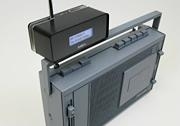Tuning in to e-waste
Don't throw out your analogue radio just yet. UNSW industrial designer Miles Park shows how smart design can extend the lifespan of products rendered obsolete, reducing the growth of e-waste.
Don't throw out your analogue radio just yet. UNSW industrial designer Miles Park shows how smart design can extend the lifespan of products rendered obsolete, reducing the growth of e-waste.

Switching to digital radio shouldn't have to mean throwing away a perfectly good analogue receiver. As Australians embrace digital radio, up to 37 million analogue radios will eventually be rendered obsolete, with many ending up in landfill. But a UNSW industrial designer has shown there are creative ways to reduce the growth of electronic waste, or e-waste.
A simple concept device, DABlife, developed by Dr Miles Park, Head of the Industrial Design program at UNSW's Faculty of the Built Environment, shows how analogue radios could be easily adapted to digital for less than the cost of a new digital receiver. The DABlife concept is the radio equivalent of the TV digital set top box, allowing an analogue radio to play digital broadcasts.
"DABlife is a way to extend the life of existing radios by piggybacking new technology onto the old. You have a unit which clips onto the aerial of your existing radio to receive the digital signal through the aerial. It then rebroadcasts the signal into the radio as an FM signal," Dr Park said.
While DABlife is yet to be commercialised, Dr Park has proven the concept and created a mockup model. It shows a simple way to extend the life of products and reduce the estimated 14.8 million electronic items sent to landfill in Australia each year.
E-waste is a global problem, with 20 to 50 million tonnes of waste electrical and electronic equipment (WEEE) dumped in landfills around the world each year. In Australia - one of the world's top 10 nations for use of information and communications technology - we buy more than 2.4 million PCs and one million televisions annually and e-waste is growing at three times the rate of general municipal waste.
Dr Park said digital radio is the latest technology "step change" - like the earlier move from VHS to DVD - which will feed the e-waste stream, with around three radios per household in Australia.
"There's quite a stock of existing AM/FM radios out there. With the introduction of digital services that doesn't mean these products are going to become obsolete overnight but it puts them on a trajectory towards obsolescence," he said.
Extending the life of products is more feasible than simply cutting consumption, Dr Park said.
"The reaction to minimising waste is to consume less and that really is not a solution in terms of the existing industrial economy and indeed for my own profession of industrial design: it's counterintuitive for what we do because we design new things that people desire," he said.
"So a way to deal with the obsolescence of e-waste is to think about new strategies in the way we can extend the lifespan of existing products or find new ways of using those products."
VideoWatch a short video demo
Media contact: Dr Miles Park | 02 9385 5263 | milesp@unsw.edu.auDenise Knight | 02 9385 8920 | 0405 207 685 | d.knight@unsw.edu.au